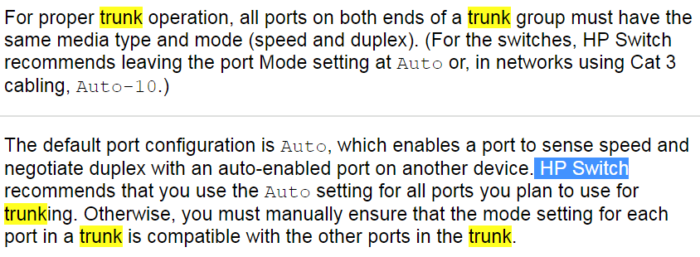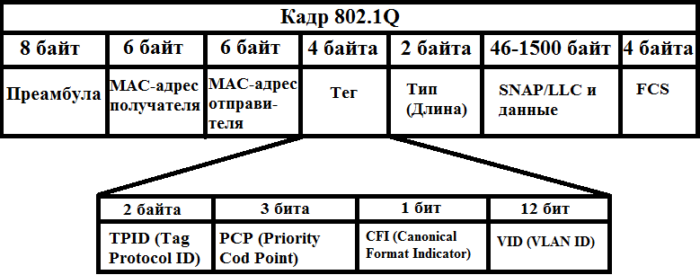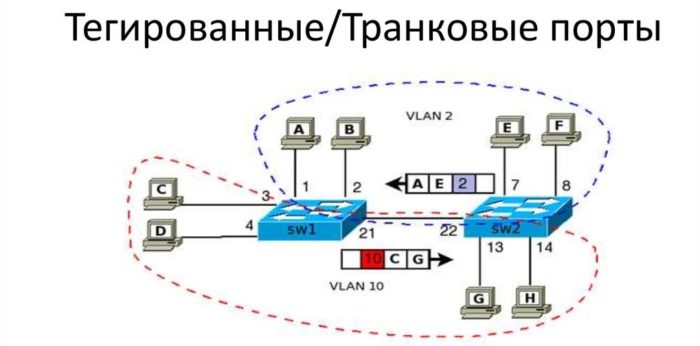How does the translation of the term trunk depend on the vendor of the switches?
I noticed this error (or, if you prefer, a different interpretation) when checking the transfer on the NETGEAR switches. The fact is that when translating the term “trunk”, it is necessary to take into account whose interpretation the vendor adheres to - Cisco or HP , because there is a very different technical meaning between them.
Let's figure it out.
Consider the problem in the following examples:
1. Cisco

2. HP

The attentive reader will note that the “trunk” in these examples has a different meaning.
We will "dig."
Cisco version

Cisco is “ trunk ”, which means a point-to-point link (link that connects two devices directly) that connects a switch and another network device, such as another switch or router. Its task is to transmit the traffic of several VLANs through one channel and provide them access to the entire network . In common people it is called “trunk” , which is logical.
Operating principle
Let's start with what is a vlan?
VLAN stands for Virtual local area network or virtual local area network. It is a technology that allows you to divide one physical network into several logical, operating independently of each other. For example, there is an enterprise personnel department , accounting and IT-department . They have their own switches, which are connected through a central switch into a single network, and now the networks of these departments need to be separated from each other. That's when VLAN technology comes to the rescue.

This is how a network looks like divided into VLANs (virtual networks).
Often, different colors are used to designate VLANs.

So the ports marked in green enter one VLAN, and the ports marked red in another. Then computers that are in the same VLAN can only communicate with each other , but they cannot communicate with computers belonging to another VLAN.
Changes in the switching table in the VLAN
When creating VLANs, another field is added to the switching table at the switches, in which the VLAN IDs are specified. Simplified, it looks like this:

Here we see that ports 1 and 2 belong to VLAN 2 and ports 3 and 4 belong to VLAN 10.
Go ahead. At the link level, data is transmitted as frames ( frames ). When transferring frames from one switch to another, information is needed about which VLAN a frame belongs to. This information is added to the transmitted frame. At this time, the open standard IEEE 802.1Q is used for this purpose. Step-by-step frame evolution in VLAN
- The computer generates and sends the usual frame (frame, it is the data link layer, i.e. the switch level) , without adding anything. This frame looks like this:

- The switch receives a frame. In accordance with the switching table, he understands which computer the frame came from and which VLAN the computer belongs to. Then the switch itself adds overhead, so-called tag , to the frame . A tag is a field after the sender's MAC address, which contains, roughly speaking, the VLAN number. This is the frame with the tag:

The switch then sends this frame to another switch.
The switch that receives the frame, extracts the VLAN information from it, that is, understands which computer to transmit this frame to, removes all the service information from the frame and transfers it to the recipient's computer.
A frame comes to the recipient’s computer without the service information.
Now back to our “ trunk 'y”. Switch ports that support VLANs can be divided into two groups:
- Tagged ports (or trunk ports from Cisco )
- Untagged ports (or access ports )
We are interested in tagged ports or trunk ports. They serve to ensure that data belonging to different VLANs can be transmitted through one port and receive data from several VLANs to one port (we remember that we usually do not see ports from different VLANs) .

In this illustration, ports 21 and 22 are tagged, which connect two switches. Frames will pass through them, for example, from computer E to computer A , which are in the same VLAN, according to the scheme described above.
So, the communication channel between these ports at Cisco is called the “ trunk ”.
HP version
How does the company interpret this term?

Here generally it is not about VLAN. In the case of HP, we are talking about channel aggregation technology. They have a “trunk” - a logical channel that combines several physical channels . Such a combination allows to increase the capacity and reliability of the channel. Let us consider an example. Suppose we have two switches, each of which has four ports and these ports are interconnected by four wires.

If you leave everything as it is - just the connections between the switches - then these connections will transmit frames to each other in a circle, i.e. form loops (and broadcast frames will be duplicated time after time, introducing the switches into a broadcast storm) .
Such duplicate connections are considered redundant , and they need to be eliminated, for this purpose there is a Spanning Tree Protocol (STP). Then out of our four connections, STP will turn off three, because it considers them redundant, and only one connection will remain.
So, in the case, if we combine these four physical channels, between the switches there will be one logical channel with increased throughput (the maximum information transfer rate over the communication channel per unit time ). That is, four channels are involved at once, and the problem with redundant connections has been resolved. That's exactly this logical (aggregated) channel called by the HP “ trunk 'om”.

Link aggregation can be configured between two switches, a switch and a router. Up to eight physical channels can be combined into one logical channel. It is important that all ports that are combined into an aggregated channel have the same parameters:
- media type (twisted pair, fiber, etc.) ,
- speed,
- flow control and duplex mode.
If one of the ports in the aggregated link fails, the link will continue to operate. Ports of the aggregated channel are perceived as a whole, which corresponds to the idea of a logical channel.
And to fully clarify the picture, we note that this technology from Cisco is called EtherChannel . EtherChannel is a channel aggregation technology developed by Cisco . The meaning is the same, it allows you to combine several physical Ethernet channels into one logical channel.

Thus, the term trunk is translated depending on the context as follows:
Cisco switch documentation - trunk port, tagged port, trunk port ;
HP switch documentation - aggregated port, aggregated link .
In case you want to understand the topic in more detail, below is a small list of sources.
Cisco: https://content.cisco.com/chapter.sjs?uri=/searchable/chapter/content/en/us/td/docs/switches/lan/catalyst3850/software/release/3se/vlan/configuration_guide/b_vlan_3se_3850_cg /b_vlan_3se_3850_cg_chapter_0110.html.xml&searchurl=https%3A%2F%2Fsearch.cisco.com%2Fsearch%3BeanBarabeardBansBalware2DenUS%26Betap (or so: https://bitly.su/OC4VB7)
Link aggregation: http://xgu.ru/wiki/%D0%90%D0%B3%D1%80%D0%B5%D0%B3%D0%B8%D1%80% D0%BE%D0%B2 % D0% B0% D0% BD% D0% B8% D0% B5 % D0% BA% D0% B0% D0% BD% D0% B0% D0% BB% D0% BE% D0% B2 # .D0.90.D0 .B3.D1.80.D0.B5.D0.B3.D0.B8.D1.80.D0.BE.D0.B2.D0.B0.D0.BD.D0.B8.D0.B5 .D0.BA .D0.B0.D0.BD.D0.B0.D0.BB.D0.BE.D0.B2_.D0.B2_ProCurve
')
Source: https://habr.com/ru/post/450494/
All Articles